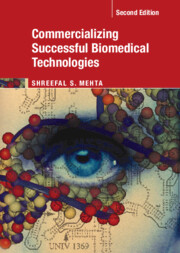Book contents
- Commercializing Successful Biomedical Technologies
- Commercializing Successful Biomedical Technologies
- Copyright page
- Dedication
- Contents
- Preface
- Acknowledgments
- 1 The biomedical device and drug industry and their markets
- 2 Markets of interest and market research steps
- 3 Starting up your company
- 4 Intellectual property and licensing
- 5 New product development (NPD)
- 6 The regulated market: gateway through the FDA
- 7 Manufacturing
- 8 Reimbursement, marketing, sales, and product liability
- Glossary
- Index
- References
1 - The biomedical device and drug industry and their markets
Published online by Cambridge University Press: 03 November 2022
- Commercializing Successful Biomedical Technologies
- Commercializing Successful Biomedical Technologies
- Copyright page
- Dedication
- Contents
- Preface
- Acknowledgments
- 1 The biomedical device and drug industry and their markets
- 2 Markets of interest and market research steps
- 3 Starting up your company
- 4 Intellectual property and licensing
- 5 New product development (NPD)
- 6 The regulated market: gateway through the FDA
- 7 Manufacturing
- 8 Reimbursement, marketing, sales, and product liability
- Glossary
- Index
- References
Summary
The vast world of biotechnology applications to human health is reviewed and the terminology used in the rest of the book is defined here. An overview of the industry, the value chains, the specific types of human health products covered in this text are presented in this chapter. A time-tested way to analyze an industry’s attractiveness for new entrants is presented here using Porter’s five forces model. Technology trends such as mobile health, artificial intelligence, 3D printing, cell and gene therapy, and robotics are presented to the reader in the context of the mission of improving human health. The overall process of development of new products in these various segments of drugs, devices and diagnostics sectors is reviewed here. The reader will leave this chapter with a 30,000-foot view of the industry dynamics and understand the context within which product commercialization is to be done.
Keywords
- Type
- Chapter
- Information
- Commercializing Successful Biomedical Technologies , pp. 1 - 41Publisher: Cambridge University PressPrint publication year: 2022

